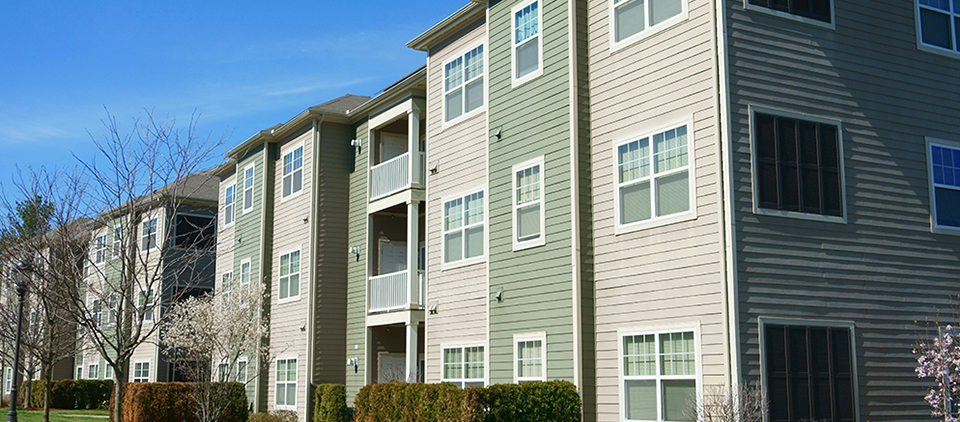Investors on the sidelines waiting for distressed multifamily prospects are missing the opportunity in front of them

Investors have long praised the resilience of the multifamily property sector. One big reason: During previous economic downturns, multifamily generally has outperformed other major property segments. According to a 2019 CBRE report:
- during the 2001 recession, U.S. multifamily property rents declined less than those of office and industrial properties – and their growth rate was considerably higher post-recession;
- during the 2008-2009 recession, multifamily rents were more resilient than those of office, industrial, and retail; and
- since 2008-2009, multifamily rents have outperformed those of the other major property sectors in showing the lowest level of rent decline, the fastest recovery to pre-recession peaks, and the longest post-recession period of rent growth.
COVID-19 hit the commercial real estate market hard in Q2 2020. Its global impact was at first predicted to act as a traditional recessionary event. But as we analyze the pandemic’s effect on private equity real estate transaction activity in the U.S., we see that this traditional viewpoint is both true and somewhat misleading. The implication? Investors waiting on the sidelines for distressed multifamily deals may be waiting a long time.
And the sheer volume of capital on the sidelines – for whatever reason – is staggering. According to Preqin, just $7.3B of private equity real estate deals were completed in Q2, less than one-quarter of the $31B in such deals completed in Q1. This has left a record amount of dry powder – about $147B – in the hands of fund managers “poised to return to the market as it emerges from this crisis.” (Preqin U.S. Commercial Real Estate Report, p. 3, July 2020)
Where will that money go? Multifamily is a likely destination, if only for the resilience it has shown in past downturns. But this time the speed of recovery seems to have caught some investors flat-footed, like poker players waiting on that perfect hand before they move in their chips. Those waiting for significant distress to materialize in the multifamily space risk missing opportunities emerging right now.
Let’s look at our hometown market of Dallas-Fort Worth (DFW) as an example. As noted, despite the global impacts of COVID-19, investors are still bullish on multifamily. Generally speaking, rents are stable and continue to be affordable relative to most comparable markets, especially on the coasts. In March, just before COVID hit, DFW led the nation in job growth.1 And while DFW was not immune from record-setting job losses in April (6%) and May (7.5%), it still outperformed 10 of the other 11 largest U.S. markets, according to the Bureau of Labor Statistics.2 In fact, the DFW metro area just recently ranked as one of only eight in the country where rents are forecast to end the year higher or flat, suggesting that the local apartment market has stabilized from its earlier decline due to COVID-19. (Dallas Business Journal, August 7, 2020)
What does all this look like on the ground? Big multifamily deals are getting done. For example, two major Dallas-based multifamily players just completed the largest DFW apartment transaction in 15 years when Lone Star Funds acquired a five-property portfolio totaling nearly 2,000 units from prolific developer JPI. In another example, continuing the recent trend of increasing interest in DFW among international investors, a joint venture between Canadian and U.S. investors purchased 1,200 units for $178MM in August.
These transactions are notable for their size, but they are not outliers. Despite a dip in investment activity, real estate data aggregator Real Capital Analytics (RCA) ranked Dallas as the No. 1 U.S. commercial property market – for the first time ever – at the halfway mark of the year. Dallas overtook Manhattan and Los Angeles, where sales activity fell by more than 40%.3 Gateway markets continued their steep year-over-year apartment rent declines as well, with San Jose (-5.0%) and San Francisco (-4.1%) leading the way, according to Yardi. Meanwhile, Yardi expects several U.S. markets to show annual rent growth by year’s end, including DFW, Kansas City, Tampa, Phoenix, and Nashville.4

What else is driving multifamily investors to acquire assets now, rather than waiting for distress? Other key factors include:
Cap rates/pricing remain unchanged5. With transaction activity down for the year, there is a smaller and more eclectic sample of cap rate data points for the apartment market. However, using its Hedonic Series, which employs a statistical model to control for quality differences between properties, RCA calculates the national average multifamily cap rate at 5.3%, unchanged from the prior year.
Interest rates are at an all-time low. The U.S. Federal Reserve cut benchmark interest rates to near zero to support the economy during the coronavirus pandemic. This increases the spread between investors’ cost of debt and the unlevered return generated by prospective multifamily acquisitions. This accretive leverage is keeping multifamily asset values steady or even growing, especially in DFW and the handful of other markets forecasted to see rents stay where they are or grow slightly. According to Bruce Flatt, CEO of Brookfield Asset Management, his firm is starting to “see bids for real estate and infrastructure assets at higher multiples than pre-COVID.”
Distressed multifamily transaction volume low so far. For the second quarter, distressed sales only accounted for 1% of total U.S. commercial real estate transaction volume. Unlike the Great Recession, in which distress was more evenly distributed amongst all asset types,6 over 90% of currently distressed real estate assets are hotels and retail properties. The overall impact on the hospitality and retail market is truly unprecedented. According to a July 1 report, 36% of CMBS hotel borrowers and 23% of CMBS retail borrowers have indicated need for relief due to the pandemic. The multifamily sector has been much more resilient with only 2.7% of agency multifamily borrowers needing relief due to the pandemic, the lowest of any property sector. Overall, these data suggest the multifamily sector is unlikely to experience anything approaching the tidal wave of distress that has hit hospitality and retail so hard. Having said that, however, multifamily default rates will probably get worse before they restabilize. This will force some owners and lenders to sell mismanaged and overleveraged properties, which certainly will create attractive opportunities, just not to a great degree. Civitas expects the volume of such opportunities to be insufficient to soak up the tens of billions of dollars institutional investors have allocated to multifamily.
Of course, the environment will continue to be shaped by rapidly evolving U.S. policy – economic, fiscal, and monetary. So far, despite the worst GDP decline since the Great Depression, apartment fundamentals have held steady.7 This is true in large part because, in contrast to the deliberate governmental inaction in the aftermath of the 1929 stock market crash that marked the beginning of the Great Depression, COVID prompted immediate and unprecedented government intervention to stabilize the economy. For example, the CARES Act created the Paycheck Protection Program (PPP) loans that thousands of businesses have received to the tune of over $5218 billion to help keep them afloat. In addition, the law provided millions of households suffering job losses an incremental $600 per week on top of existing unemployment benefits – which they used to pay rent. In fact, REIS’s rent collection loss surveys suggest that there was actually an improvement over the months of April to June, with rent collection losses falling from 4.8% to around 4.6%. These metrics are consistent with performance indicators monitored by the National Multi-Housing Council.
But the extra $600 per week benefit expired on July 31, which some prominent economists, such as Nobel laureate Paul Krugman, believe will result in a sharp additional economic contraction when millions of unemployed Americans lose – and therefore stop spending – 60% of their income. As of this writing, it is too early to judge whether Krugman’s dire prediction will come true. Congress is still debating an additional COVID relief bill, which Civitas expects will include an extension of the enhanced unemployment insurance benefit, but at a lower rate. This would provide a smoother transition and give the economy more time to recreate the 22 million jobs that were lost in a matter of weeks. The implications of this policy decision could be significant for multifamily sector performance.
And in another notable curveball, the Trump Administration announced on September 1 a nationwide eviction moratorium through the end of 2020. The policy covers 43 million American renters, provided they meet certain income criteria and other eligibility requirements. The move was welcomed by affordable housing advocates, but it is a stopgap at best, because it does not relieve tenants of their obligation to pay rent, but merely delays it. Absent a robust rental assistance program, the likely result is for many affected tenants a financial cliff at the end of the year. From an investor’s perspective, the moratorium creates new risk for rental property owners. Representing this view, Doug Bibby, President of the National Multifamily Housing Council, said in a statement that the government’s failure to pair the moratorium with a robust rental assistance program is a major policy error that could threaten “the stability of the entire rental housing sector.”
We think Bibby may be overstating the case. Obviously, landlords cannot replace the current income lost when a tenant that fails to pay rent because the unit cannot be re-leased to a paying tenant, and the likelihood of collecting accrued rent in a balloon payment in January is low. Without that income, some landlords may be unable to service their debt or pay other fixed obligations, such as property taxes, which could lead to foreclosures. Further, the moratorium could encourage even tenants able to pay rent to refrain from doing so, as they cannot be evicted. On the other hand, since the pandemic began, states and some local jurisdictions have imposed eviction moratoria, and the sky has not fallen – quite the opposite. Even in jurisdictions with such moratoria in place, collections have generally remained strong. This has certainly been Civitas’ experience in Texas to date; even the property in the smallest market in our portfolio has continued to perform very well. This may be due to the financial cliff the moratorium creates; tenants are not stupid, and many do not want to be forced to move in 120 days. Also, while they cannot be evicted for a few months, nonpaying tenants still face other negative consequences, such as fees, penalties, interest, and – perhaps most important, especially for tenants of higher-end Class A properties – the threat of derogatory reports to credit bureaus that will sharply lower their FICO scores.
In its July 2020 multifamily report, Yardi concludes its market analysis with a question: “Could this be the start of a turnaround?” For multifamily, its historical resilience in recessions, ultra-low interest rates, and the relative lack of distressed opportunities on the horizon suggest the multifamily sector may not end up having a great deal of turning around to do. Of course, risks remain, as always; COVID-19 is uncharted territory. But it is Civitas’ job to evaluate opportunities in the real world, without a crystal ball and with incomplete information. On a risk-adjusted basis, we believe multifamily – in the right markets, with the right basis, with the right sponsorship – offers compelling opportunities for investors.
1 Source: U.S. Bureau of Labor Statistics
2 Source: U.S. Bureau of Labor Statistics
3 Source: Real Capital Analytics, Capital Trends US Big Picture, August 2020
4 Source: Yardi Matrix, National Multifamily Report, July 2020.
5 Source: Real Capital Analytics, Capital Trend US Apartment, August 2020
6 Source: Real Capital Analytics, Capital Trends US Big Picture, August 2020
7 Source: Reis, Q2 2020: Apartment at First Glance, July 2020
8 Source: SBA, Paycheck Protection Program (PPP) Report, June 2020
9 Source: Reis, Q2 2020: Apartment at First Glance, July 2020

